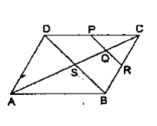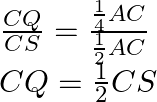Answer:

We know that the diagonals of a parallelogram bisect each other.
Therefore,
CS = ![]()
AC …(i)
Also, it is given that CQ = ![]()
AC …(ii)
Dividing equation (ii) by (i),

Q is the midpoint of CS
According to midpoint theorem in ∆CSD
PQ || DS
If PQ || DS,
QR || SB
In ∆ CSB, Q is midpoint of CS and QR ‖ SB.
Applying converse of midpoint theorem,
Conclusion – R is the midpoint of CB.
Hence, proved.
